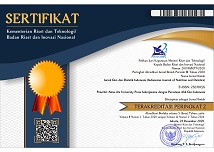Frequency of online food ordering is not risk factor of central obesity in women aged 20 - 49 years
Abstract
ABSTRAK
Latar Belakang: Obesitas adalah masalah kesehatan dunia dengan prevalensi terus meningkat dari tahun ke tahun. Wanita secara umum lebih banyak mengalami masalah berat badan dibandingkan dengan laki-laki. Perkembangan teknologi berpengaruh terhadap gaya hidup sedentari yang menyebabkan kenaikan berat badan. Wanita paling sering melakukan pemesanan makanan online dibandingkan laki-laki.
Tujuan: menganalisis hubungan frekuensi pemesanan online food dengan obesitas sentral pada wanita usia 20 -49 tahun.
Metode: jenis penelitian ini adalah penelitian observasional analitik dengan rancangan potong lintang (cross-sectional). Populasi adalah wanita dewasa usia 20 – 49 tahun. Total 120 wanita usia 20 - 49 tahun diobservasi status gizi dan frekuensi pemesanan online food. Lingkar perut digunakan untuk menentukan status obesitas sentral dari wanita. Wanita dikategorikan obes jika dia mempunyai lingkar perut >80 centimeter dan tidak obes jika lingkar perut ≤80 centimeter. Variabel paparan utama adalah frekuensi pemesanan online food yang dikategorikan menjadi ≥ 3 kali dan < 3 kali dalam seminggu. Kovariat adalah karakteristik responden yang meliputi usia, tingkat pendidikan, status pekerjaan, status pernikahan, dan aktivitas fisik. Data dianalisis menggunakan analisis univariat (frekuensi dan persentase) dan analisis bivariat (chi-square).
Hasil: Hasil penelitian ini menunjukkan bahwa 70,8% responden mengalami obesitas sentral. Rata-rata lingkar perut responden adalah 85,0 centimeter. Sebagian besar responden (60,8%) pernah melakukan pemesanan online food. Makanan yang paling banyak dipesan responden antara lain ayam goreng, nasi goreng, martabak / roti panggang, dan pizza. Analisis bivariat menunjukkan bahwa karakteristik responden tidak berhubungan signifikan dengan kejadian obesitas sentral. Tidak ada hubungan signifikan antara frekuensi pemesanan online food dengan kejadian obesitas sentral pada wanita dewasa usia 20 - 49 tahun (p=0,325).
Kesimpulan: frekuensi pemesanan online food ≥ 3 kali seminggu bukan faktor risiko obesitas sentral pada wanita dewasa.
KATA KUNCI: aplikasi smartphone; obesitas sentral; online food; wanita
ABSTRACT
Background: Obesity is a global health problem with prevalence increasing from year to year. Women, in general, have more weight problems than men. Technological developments affect sedentary lifestyles that cause weight gain. Women are more often ordering food online than men.
Objectives: To analyze the relationship between the frequency of online food ordering with central obesity in women aged 20 - 49 years.
Methods: This study was an analytic observational study with a cross-sectional design. The population was women aged 20 - 49 years. A total of 120 women aged 20-49 years were observed for their nutritional status and frequency of online food ordering. Waist circumference was used to determine the status of central obesity in women. The woman was categorized as obese if she has waist circumference > 80-centimeters and not obese if waist circumference ≤ 80 centimeters. The main exposure was the frequency of online food ordering that was categorized into ≥ 3 times and < 3 times a week. Age, education level, employment status, marital status, and physical activity were analyzed using univariate analysis. The bivariate analysis was also conducted to analyze relations between variables.
Results: Results showed that 70.8% of respondents have central obesity. Respondent’s average waist circumference was 85.0 centimeters. Most of the respondents (60.8%) have ordered food online. Respondents’ top-ordered foods include fried chicken, fried rice, martabak (fried crepe filled with egg, and vegetable) and pizza. Bivariate analysis showed that there was no significant relationship between characteristics of respondents with central obesity. There was no significant relationship between the frequency of online food ordering with central obesity in women aged 20 - 49 years (p = 0.325).
Conclusion: online food ordering frequency 3 times a week is not a risk factor for central obesity in women aged 20 - 49 years.
KEYWORDS: central obesity; online food; smartphone applications; women
Keywords
Full Text:
PDFReferences
Malik VS, Willett WC, Hu FB. Global obesity: trends, risk factors, and policy implications. Nature Reviews Endocrinology. 2013;(9)13 -27.
Muhammad HF. Obesitas Translasional Aspek Klinis dan Molekuler dari Kejadian Obesitas. Yogyakarta: Gadjah Mada University Press; 2017.
Tsai AG, Williamson DF, Glick HA. The direct medical cost of overweight and obesity in The United States: a quantitative systematic review. Obes Rev. 2011;12 (1):50-61.
Ng M, Fleming T, Robinson M, Mullany EC, Biryukov S, Achoki T, et al. Global, regional, and nurtitional prevalence of overweight and obesity in children and adults during 1980-2013: a systematic analysis for the global burden of disease study 2013. Lancet. 2014; 384(9945):766-81.
Ministry of Health. National Institute of Health Research and Development. Baseline Health Research 2018 (Riskesdas 2018). Jakarta : Ministry of Health Republic of Indonesia.
Amalia L, Endro OP, Damanik MR. Preferensi dan frekuensi konsumsi makanan jajanan pada anak sekolah dasar di Kecamatan Cijeruk, Kabupaten Bogor. Jurnal Gizi dan Pangan. 2012;119-126.
Alagoz SM, Hekimoglu H. A study on tam: analysis of customer attitudes in online food. Elsevier. 2012;62 ( 2012): 1138 – 1143.
Aditya R, Singh A, Pathan S, Kanade V. Online food ordering system. International Journal of Computer Applications. 2017;6(180): 22-24.
Kimes SE. Customer perceptions of electronic food ordering. Cornell Hospitality Report. 2011;11(10):1-17.
Dang AK, Tran BX, Nguyen CT, Le HT, Do HT, Nguyen HD, et al. Consumer preference and attitude regarding online food products in Hanoi, Vietnam. International Journal of Environmental Research and Public Health. 2018;15 (981):1-12.
Stephens J, Miller H, Militello L. Food delivery apps and the negative health impacts for Americans. Frontiers in Nutrition. 2020: 7.
Pemerintahan Kabupaten Sleman. Buku Penduduk 2016.
Schnellbächer C, Behr J, Leonhäuser IU, Gießen. Potential of online food shopping. Ernaehrungs Umschau international. 2015:178 – 187.
Harahap LA, Aritonang E, Lubis Z. The relationship between type and frequency of online food ordering with obesity in students of Medan Area University. Britain International of Exact Sciences Journal. 2020: 29 -34.
Adriani, M., & Wirjatmadi. (2012). Pengantar gizi masyarakat. Jakarta: Kencana, 2012.
Kementerian Kesehatan Republik Indonesia Direktorat Pencegahan dan Pengendalian Penyakit Tidak Menular. Aktifitas fisik ringan. http://p2ptm.kemkes.go.id/infographic-p2ptm/obesitas/page/29/aktivitas-fisik-ringan
DOI: http://dx.doi.org/10.21927/ijnd.2021.9(1).19-26
Refbacks
- There are currently no refbacks.

This work is licensed under a Creative Commons Attribution-ShareAlike 4.0 International License.
Indonesian Journal of Nutrition and Dietetics (IJND) indexed by:
 View My Stats
View My Stats



12.png)


























